Native breeds key to managing Thoresby Estate’s ancient landscapes
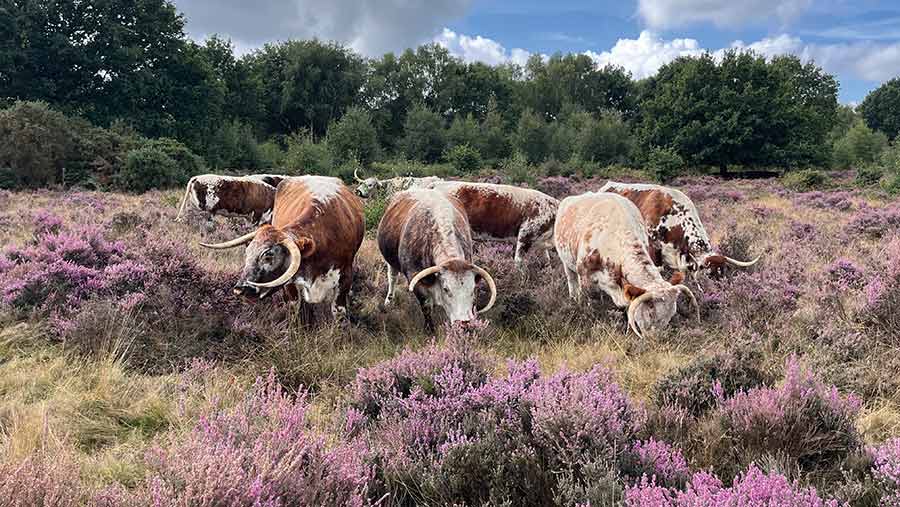 © Hayley Chapman
© Hayley Chapman A Nottinghamshire farming business is using native cattle and sheep to balance profitable food production and ancient landscape management.
Thoresby Estate has an arable area stretching 30 miles top to bottom and a livestock enterprise managing multiple breeds in a variety of landscapes – including woodland that was part of the original Sherwood Forest.
The Estate aims to balance the farm and the land harmoniously to benefit the environment and the business.
“If we can tick a lot of boxes, with something working for the arable, livestock and the environment we manage, that’s what we are trying to achieve,” says farm manager Will Baker.
See also: Farmers Weekly Awards 2022: Mixed Farmer of the Year finalists
Farm facts: Thoresby Farming
- Thoresby estate: 3,240ha (8,000 acres), with 1,012ha (2,500 acres) arable land, 100ha (250 acres) permanent pasture – used for events as well as livestock – and 150ha (370 acres) ancient oak woodland
- Thoresby Arable farms a further 2,500ha (6,175 acres) on contract and tenancies, growing wheat, barley, maize, sugar beet, oilseed rape, onions, carrots and potatoes
- Native breeds grazed on the estate woodland as well as Clumber Park (oak woodland) and Budby Heath to fulfil demand from National Trust and RSPB, respectively
Thoresby Livestock runs a herd of English Longhorn cows and flock of Hebridean ewes to provide conservation grazing on the estate’s own ancient oak woodland, the Budby Heath nature reserve, managed by RSPB, and the National Trust’s Clumber Park, which borders the estate.
The 1,000-head commercial flock is mainly grazed on the estate’s permanent grassland and forage crops within the arable rotation.
Production systems of the Thoresby herd and flocks
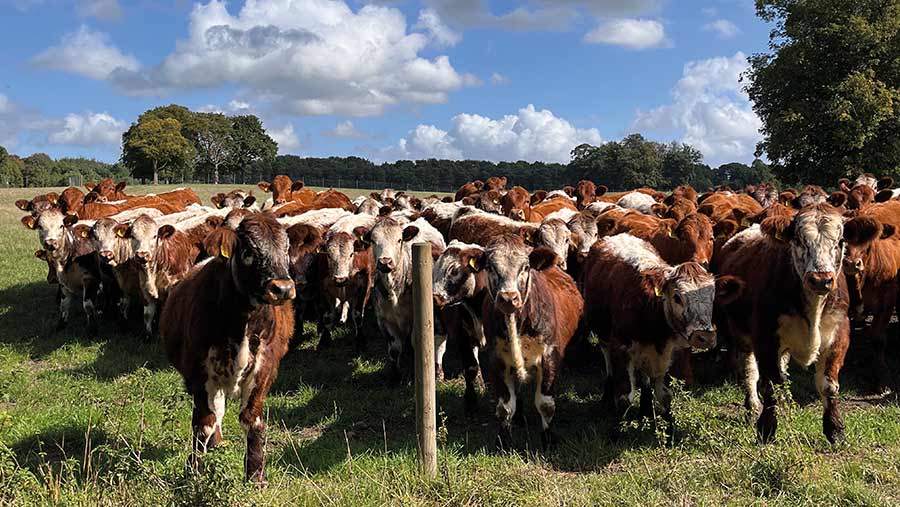
© Hayley Chapman
The English Longhorn herd
- 130 English Longhorn cows, 3 English Longhorn bulls, one Limousin bull
- Calving inside from October to December, but cows outside the rest of the year
- All bull calves disbudded
- Cows turned out to cover crops or maize stubble and fed straw and silage during winter period and moved to heathland or woodland for summer
- Calves weaned end of April and grazed on new grass leys, with creep feed for younger calves
- Cattle finished inside on barley straw and food manufacturing by-products
- Stock primarily sold fat through market or deadweight, with some sold as store cattle if prices are good
The Hebridean flock
- 200 Hebridean ewes grazed in woodland
- Lambed outside in late spring
- 100 ewes run with Hebridean tups to breed replacement ewes for park grazing
- Remainder of ewes run with Suffolk and Texel tups
- Lambs sold through market or deadweight
- Pure Hebridean lambs run to shearling before finishing
The commercial flock
- 1,000 ewes run on estate grassland and cover crops, and lambed inside February-March
- North of England and Scotch Mules put to Suffolk tups
- Suffolk-cross replacements put to Texel tups
- The aim is to get early-born lambs away end of May/early June before grass burns off on the sandy land in mid-summer
- Lambs sold at about 38-40kg earlier in the year, through mart or deadweight, and 44kg later in the season
Landscape management
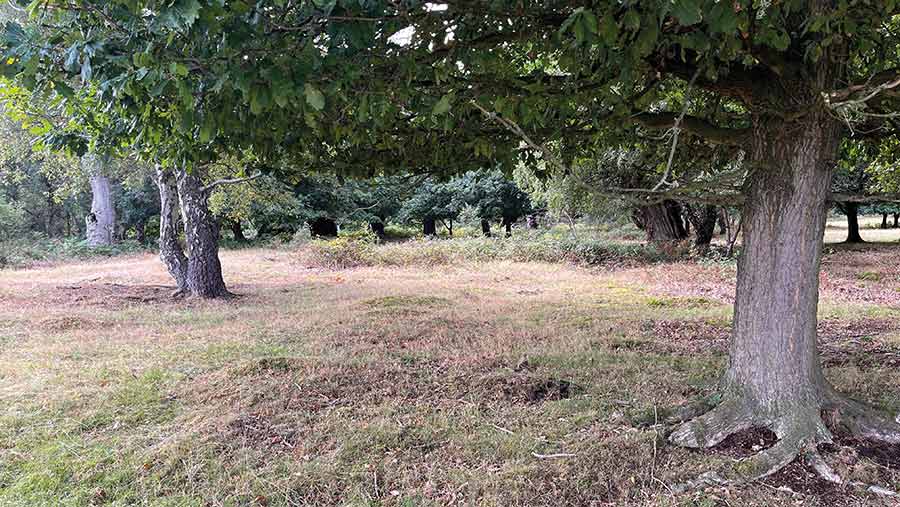
© Hayley Chapman
The native breeds have been selected for their ability to survive and thrive on parkland, heathland and in woods, while improving those landscapes.
The 600-700kg cows have the right hoofprint to trample and leave divots in the ground that can encourage new microhabitats. Their scavenging nature makes them ideal for controlling heather and silver birch.
“They’re a hell of a good suckler cow, not bad for milk, easy-calving and docile,” says David Chorlton, who oversees the livestock management, supported by his wife, Sandra, who works part-time, and full-time stockman, Robin Orr.
Much of the land the native breeds roam on is classified as a site of special scientific interest or national nature reserve and in Higher Level Stewardhip (HLS) schemes, so they are governed by strict rules.
“One of our goals is protecting the oak trees and the biodiversity they support – getting Sherwood Forest back to what it once was,” says Mr Baker.
“When the Longhorns first came in 2005, the plan was to use stock within an HLS system to create ancient oak woodland with an oak canopy and a grass floor.
“We are governed heavily on how hard we can stock areas, so it’s taking a long time, but we are getting there slowly.”
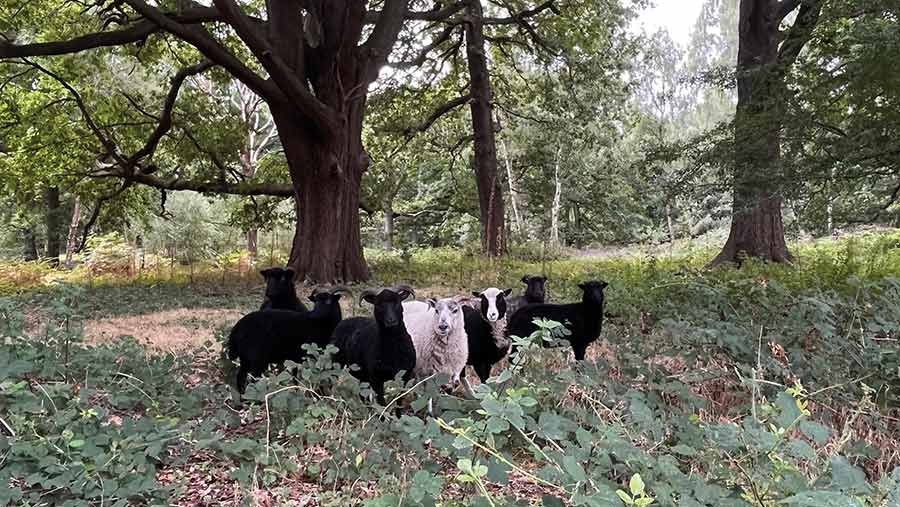
© Hayley Chapman
The Hebridean sheep then fit in with the Longhorns, with their browsing style making them ideal to nibble off brambles and bracken.
Driving profitability
The farm is constantly experimenting, trying to find new ways to drive efficiency and production.
Mr Chorlton has introduced a Limousin bull to the herd to produce some earlier-finishing cattle, while the purebred Longhorns typically take about 24 months to finish.
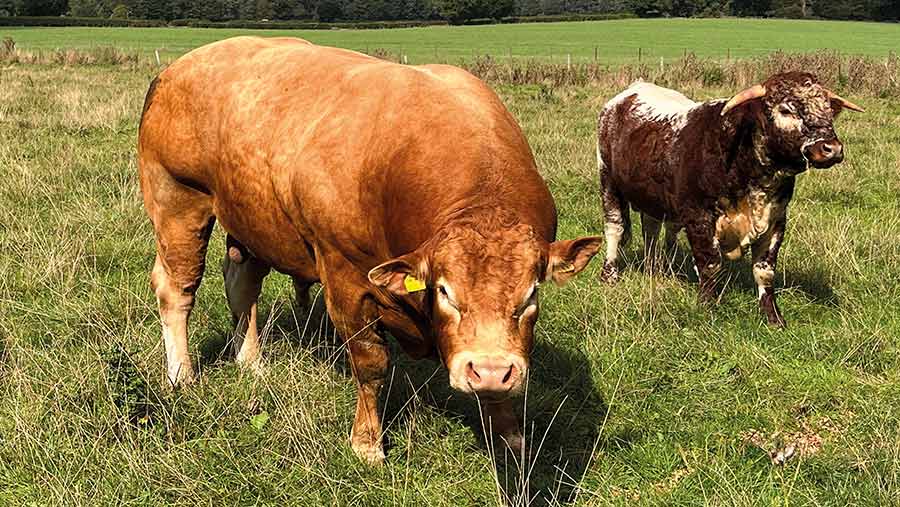
© Hayley Chapman
“If we can get the crosses away at around 15-16 months, we are getting our money back quite a bit quicker,” says Mr Chorlton.
Similarly, they are putting a Suffolk tup on some of the Hebrideans and keeping some ewe lambs as replacements in the commercial flock.
They are currently in discussions with a local butcher about selling Thoresby-branded Longhorn beef in shops and online.
It will come with the challenge of providing a continuity of supply throughout the year, but the team are keen to seize the opportunity to engage with consumers and hopefully increase profit at the same time.
Arable integration
As Thoresby Park hosts more events, such as triathlons and food markets, the pasture available for grazing is reduced. Therefore, the farm team have had to find other ways to allocate ground to the sheep and store cattle.
The arable business has been growing more cover crops – traditionally stubble turnips – but this year a brassica mix, which includes forage rape and stubble turnips, is being tried.
Another trial is with the Dutch-bred “Defender radish”. This radish is supposed to reduce the free-living nematode population in the soil, which can be a problem in vegetable crops.
And, in a “win-win for everybody”, Mr Baker says it also provided green cover for the soil, and sheep did well on it.
Each year, 49ha (120 acres) of arable land is drilled with a grass mix for a contract with Cranswick, which sees three areas of the estate leased to the pig farming business.
These areas are rented out for a three-year window and the pig units move across the farm, providing soil benefits.
The grass is planted in September and not used for pigs until the following summer when more established, so in that window it can be silaged or grazed.
“It’s a special mix that we have engineered over the years to provide as much root mass as possible to hold the land together for pigs, but it has some fast-growing stuff in it, and clover,” says Mr Baker.
“It’s nice, clean grass that we can have early in the season, which fits in with getting the lambs away early,” adds Mr Chorlton.
